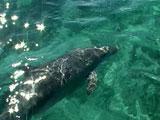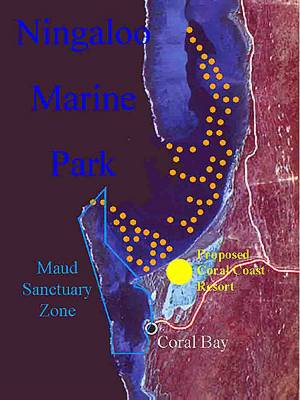CETACEANS
 The
cetacean order of mammals includes whales, dolphins and porpoises. These are
then members of one of two suborders - the toothed whales or the baleen whales.
The Ningaloo area plays host to six species of toothed whales and eight species
of baleen whales (ATA Environmental, 2000). The baleen whales are generally
sighted in the deeper waters of the Ningaloo coastline (ATA Environmental, 2000).
Five of the eight species of baleen whales found in the region are listed as
rare or likely to become extinct (ATA Environmental, 2000).
The
cetacean order of mammals includes whales, dolphins and porpoises. These are
then members of one of two suborders - the toothed whales or the baleen whales.
The Ningaloo area plays host to six species of toothed whales and eight species
of baleen whales (ATA Environmental, 2000). The baleen whales are generally
sighted in the deeper waters of the Ningaloo coastline (ATA Environmental, 2000).
Five of the eight species of baleen whales found in the region are listed as
rare or likely to become extinct (ATA Environmental, 2000).
A
majority of the dolphins found in Ningaloo Marine Park and Exmouth Gulf are
bottlenose dolphins (Preen et al, 1997). The Indo-Pacific humpback dolphin has
also been sighted in the area (ATA Environmental, 2000). The density of dolphins
in the Ningaloo and Exmouth Gulf area is comparable to the densities found in
the Great Barrier Reef and in Torres Strait (Preen et al, 1997).
 |
Humpback
whales use the southern Bateman Bay area to rest with their calves on their
journeys to and from the Southern Ocean. |
The
humpback whale is the most regular whale visitor to the Ningaloo Marine Park,
passing through twice a year. The first visit occurs in autumn during their
northern migration, and they return in their southern migration each spring
(ATA Environmental, 2000). Humpback claves and their mothers are known to rest
in the calm waters of Bateman Bay, off Maud's Landing (ATA Environmental, 2000).
This area of water is directly in front of the proposed development. Southern
right whale calves and mothers occasionally enter the same area to rest (ATA
Environmental, 2000). Other whales seen in the Ningaloo waters are minke and
blue whales (ATA Environmental, 2000). On the odd occasion, killer whales have
also been observed (ATA Environmental, 2000).
THREATS
The major threats that whales and dolphins will be susceptible to with the completion
of the proposed Maud's Landing development will be collisions with boats, ingestion
of litter, entanglement, and the pressures of more people wanting to see them.
These are all wild creatures, therefore an increased people presence and the
resulting noise may stop them from entering into Bateman Bay. This could have
unforseen consequences on the mothers and calves that use Bateman Bay as a resting
point in their long migration.
The
increased number of boats in Bateman Bay will increase the likelihood of cetaceans
being hit. It will also increase litter levels in the water, creating the potential
for the mammals to ingest plastics, a possibly fatal action. Dolphins and whales
are also very susceptible to entanglement in fishing lines and nets, which could
also be fatal.
An
increased number of tourists in the area will mean a greater number of commercial
whale watching operators and tours. This has the potential to disturb the natural
patterns of these creatures, and may cause them to avoid the area altogether.
Whales
and dolphins are an important part of the ecosystem of the Ningaloo area. They
add to the biodiversity of the system and enrich people's experiences. If they
are driven out of the area, both nature and people will suffer a great loss.
REFERENCES
ATA
Environmental 2000, Coral Coast Resort Public Environmental Review Document
Volume One, ATA Environmental, Perth.
Preen,
A.R., Marsh, H., Lawler, I.R., Prince, R.I.T. and Shepherd, R. 1997, 'Distribution
and abundance of dugongs, turtles, dolphins and other megafauna in Shark Bay,
Ningaloo Reef and Exmouth Gulf, Western Australia', Wildlife Research, Vol.
24, pp. 185 - 208.
 The
cetacean order of mammals includes whales, dolphins and porpoises. These are
then members of one of two suborders - the toothed whales or the baleen whales.
The Ningaloo area plays host to six species of toothed whales and eight species
of baleen whales (ATA Environmental, 2000). The baleen whales are generally
sighted in the deeper waters of the Ningaloo coastline (ATA Environmental, 2000).
Five of the eight species of baleen whales found in the region are listed as
rare or likely to become extinct (ATA Environmental, 2000).
The
cetacean order of mammals includes whales, dolphins and porpoises. These are
then members of one of two suborders - the toothed whales or the baleen whales.
The Ningaloo area plays host to six species of toothed whales and eight species
of baleen whales (ATA Environmental, 2000). The baleen whales are generally
sighted in the deeper waters of the Ningaloo coastline (ATA Environmental, 2000).
Five of the eight species of baleen whales found in the region are listed as
rare or likely to become extinct (ATA Environmental, 2000).
